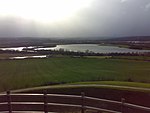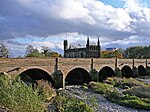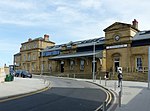Sandal Castle
12th-century establishments in England12th-century fortificationsCastles in West YorkshireGrade II* listed buildings in West YorkshireGrade II* listed castles ... and 7 more
Listed buildings in WakefieldMilitary history of YorkshireRichard of York, 3rd Duke of YorkRuins in West YorkshireScheduled monuments in West YorkshireTourist attractions in WakefieldUse British English from December 2016

Sandal Castle is a ruined medieval castle in Sandal Magna, a suburb of the city of Wakefield in West Yorkshire, England, overlooking the River Calder. It was the site of royal intrigue and the setting for a scene in one of William Shakespeare's plays.
Excerpt from the Wikipedia article Sandal Castle (License: CC BY-SA 3.0, Authors, Images).Sandal Castle
Manygates Lane, Wakefield Milnthorpe
Geographical coordinates (GPS) Address External links Nearby Places Show on map
Geographical coordinates (GPS)
| Latitude | Longitude |
|---|---|
| N 53.658889 ° | E -1.491111 ° |
Address
Sandal Castle
Manygates Lane
WF2 7DG Wakefield, Milnthorpe
England, United Kingdom
Open on Google Maps











